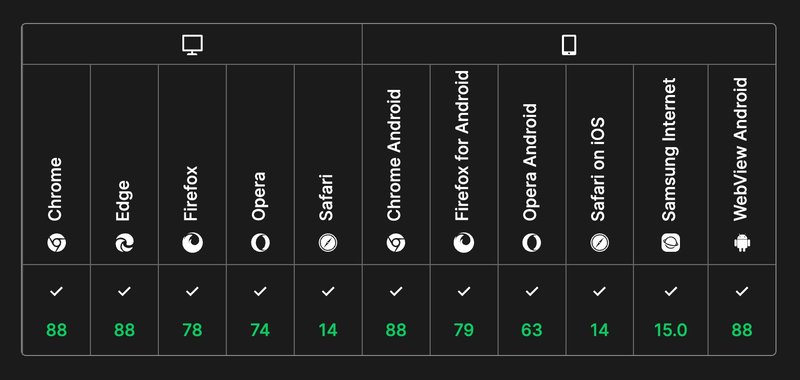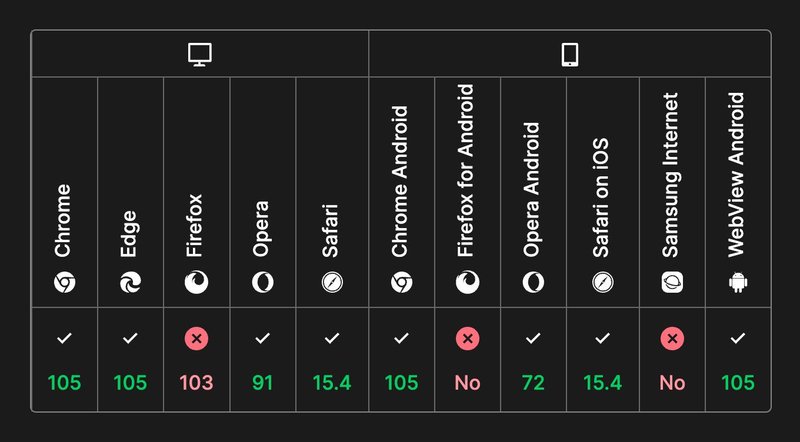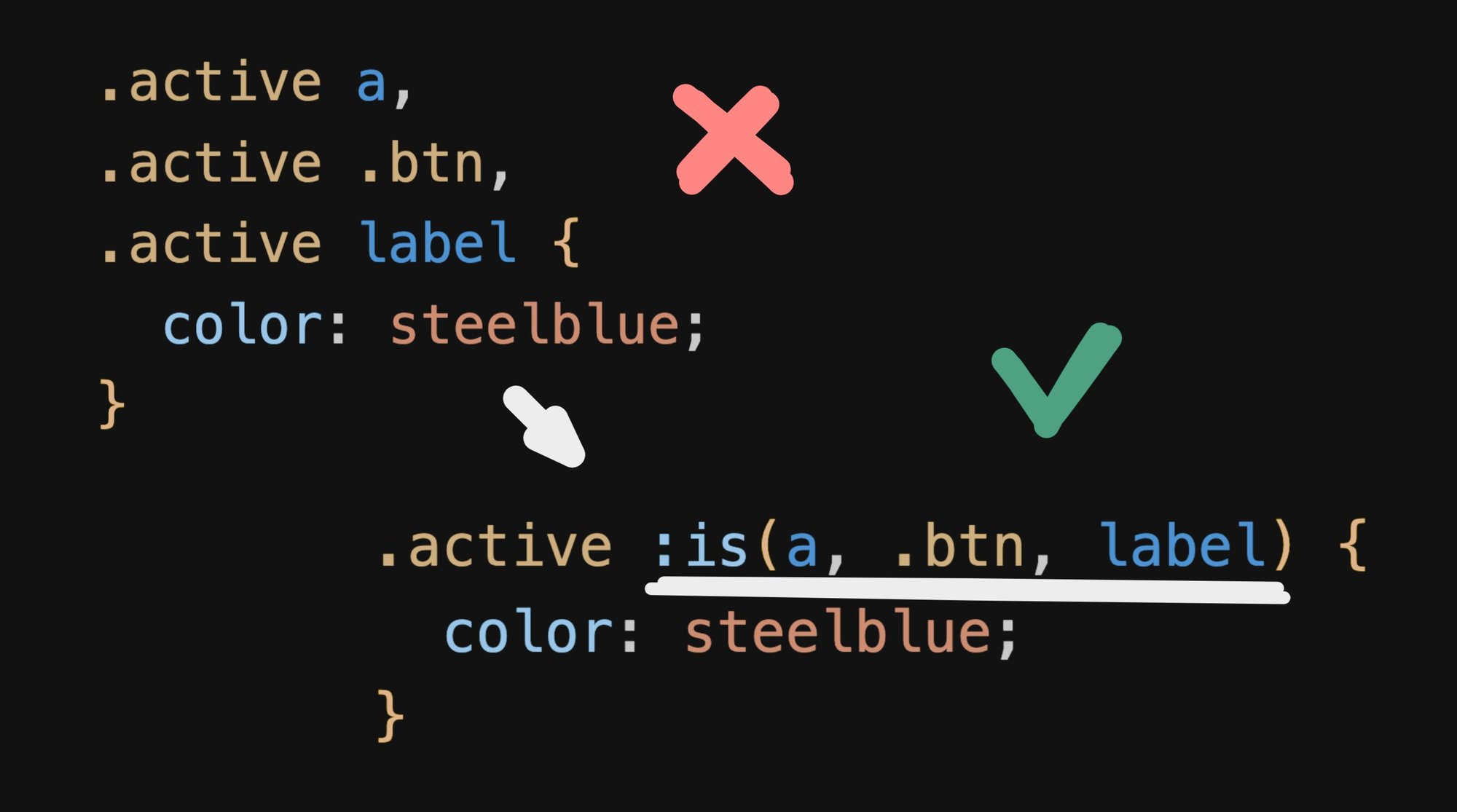If you’ve got redundant CSS selectors like this:
/* 😕 */
.active a,
.active button,
.active label {
color: steelblue;
}Did you know that you can rewrite it like this?
/* 🤩 */
.active :is(a, button, label) {
color: steelblue;
}That’s right, the :is() pseudo-class is built into plain-ole CSS now.
You can use :is() to group any part of a selector, for instance,
you could similarly transform this:
.section h2,
.aside h2,
.nav h2 {
color: steelblue;
}into just this:
:is(.section, .aside, .nav) h2 {
color: steelblue;
}But :is() is not just useful for parents and children - it can also select multiple adjoining selectors as well, like:
button:is(:focus, :hover, :active) {
color: steelblue;
}
button:is(.active, .pressed) {
color: lightsteelblue;
}Which behave equivalent to:
button:focus, button:hover, button:active {
color: steelblue;
}
button.active, button.pressed {
color: lightsteelblue;
}:where() is a very similar pseudo-class to :is() and is worth being aware of as well. They look very similar:
:where(.section, .aside, .nav) h2 {
color: steelblue;
}But the difference is that :where has a specificity of 0, whereas :is() always takes on the specificity of the most specific selector in the list.
So, do you know what color the button will be in this CSS?
:is(html) button {
color: red;
}
:where(html) button {
color: blue;
}In the above example, although the block starting with :where() is below the block starting with :is(), the :is() block has a higher specificity (1 for the html tag, + 1 for the button), vs the block below it that has a lesser specificity (0 for html because it is within :where, and +1 for button).
A related, but very different, pseudo-class is :has(). :has() allows you to select a parent that contains a child matching a selector (or set of selectors).
An example use case of :has() is to not underline links that contain an image or video:
a { text-decoration: underline }
/* Links are underlined, unless they contain an image or video */
a:has(img, video) {
text-decoration: none;
}Now, if by default our a tags have underlined text, but we have an image or video inside one, the underlining will be removed for any matching anchor elements.
You can also combine this with :is()
:is(a, button):has(img, video) {
text-decoration: none;
}**Note though that :has() is [*not* yet supported in all major browsers](https://developer.mozilla.org/en-US/docs/Web/CSS/:has#browser_compatibility), so use with caution.**Now you may be reading this and saying “SCSS can do this!”, and you may even prefer its syntax:
.active {
button, label, a {
color: steelblue;
}
}And you would be right, this is quite elegant. But it seems like every day CSS natively gets features that we once needed SCSS (or other preprocessors) for.
CSS variables has also been another incredible addition to CSS itself, that it begs the question when or how often you really need preprocessors anymore:
/* Plain ole modern CSS baby */
.active :is(a, button, label) {
--color: steelblue;
color: var(--steelblue);
}That’s not to say preprocessors don’t still have their use cases and merits.
But I think at one point in time they were truly mandatory for handling any non-trivial CSS (elegantly, at least), and now that’s not as much the case anymore.
Just to leave things on a high note, I want to point out that the future of CSS continues to look bright. The CSS Working Group is actively working on adding nested selectors directly to CSS. They are actively deciding between 3 possible syntaxes (known as options “3, “4”, and “5”):
/* Option 3 */
article {
font-family: avenir;
& aside {
font-size: 1rem;
}
}
/* Option 4 */
article {
font-family: avenir;
} {
aside {
font-size: 1rem;
}
}
/* Option 5 */
@nest article {
& {
font-family: avenir;
}
aside {
font-size: 1rem;
}
}Which do you like best? And does your choice match the winner in the official poll?
Spoiler alert - #3 won the poll, so we may be getting a very SCSS-like nesting syntax as an icing on the cake to CSS soon, assuming the CSSWG’s chooses the poll winner.
And yes, I agree, Option 4 is an absolute abomination that needs to burn in fire.
The :is() and :where() pseudo-classes are supported in all major browsers:

Source: MDN
Note that the :has() pseudo-class that we touched on here does not have the same level of support, so use :has() with caution:

Source: MDN
Modern CSS is awesome, and only keeps getting better. Next time you’ve got redundant selectors in your code - don’t forget to reach for that handy :is() pseudo-class.
About me
Hi! I'm Steve, CEO of Builder.io.
We make a way to drag + drop with your components to create pages and other CMS content on your site or app, visually.
You can read more about how this can improve your workflow here.
You may find it interesting or useful:
Builder.io visually edits code, uses your design system, and sends pull requests.
Builder.io visually edits code, uses your design system, and sends pull requests.




 Connect a Repo
Connect a Repo








